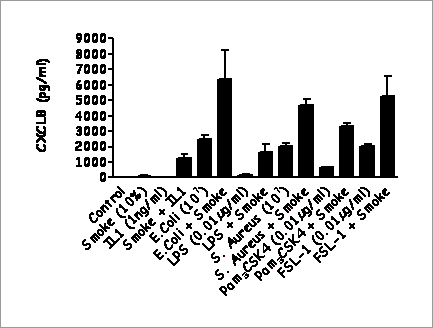Souluble cigarette smoke extract synergises with bacterial pamps Epidemiological studies suggest that the risk of death from heart attack or stroke is increased by recognised risk factors which include smoking cigarettes, diabetes, high cholesterol or elevated blood pressure. Most recently infection has been recognised and included as a potential risk factor for cardiovascular death. However, the way in which these risk factors interact at the cellular level is not know, making our understanding of the epidemiology difficult to interpret. In addition to cardiovascular deaths, smoking and infection are recognised as additionally important in the progression and exacerbation of chronic obstructive pulmonary disease (COPD). We have previously shown that cigarette smoke activates human monocytes via an oxidative stress dependent mechanism mediated by AP-1 (Walters et al., 2005) and that a similar phenomenon occurs in smooth muscle cells. In the current study we have investigated how bacterial pathogen associated molecular patterns (PAMPs) interact with cigarette smoke to activate human monocytes to release the neutrophils selective chemokine, CXCL8. Human monocytes (THP-1) and cigarette smoke extract (CSE) were prepared and used as we have described previously (Walters et al., 2005). Cells were stimulated with smoke at 10% dilution in the presence or absence of heat killed E. coli (107CFU/ml), S. aureus (107CFU/ml), PAM 3 CSK4, which activates Toll like receptor (TLR) 2 and 1 (10μg/ml), FSL-1, which activates TLR2 and 6 (10ng/ml) and LPS, which activates TLR4 (0.01 m g/ml) for 24 hours, after which time medium was removed for the measurement of CXCL8 by ELISA (Walters et al., 2005).
Figure 1: Results are the mean± S.E.M. for n=4. CSE synergised with each PAMP tested on human monocytes to release CXCL8. These results are the first to show an interaction between specific PAMPs and cigarette smoke. Our findings provide evidence for the hypothesis that concurrent risk factors in populations compound the chance of cardiovascular or respiratory disease.
Walters MJ, Paul-Clark MJ, McMaster SK, Ito K, Adcock IM, Mitchell JA. Mol Pharmacol. 2005 in press. |


